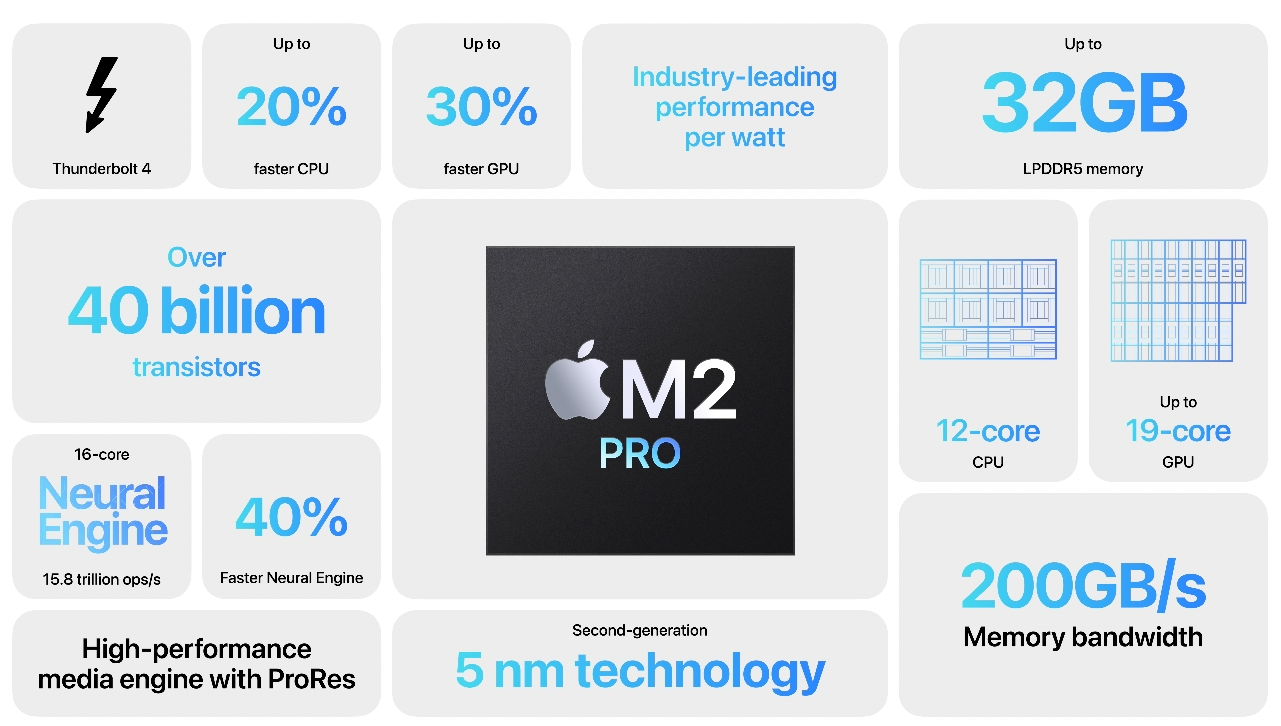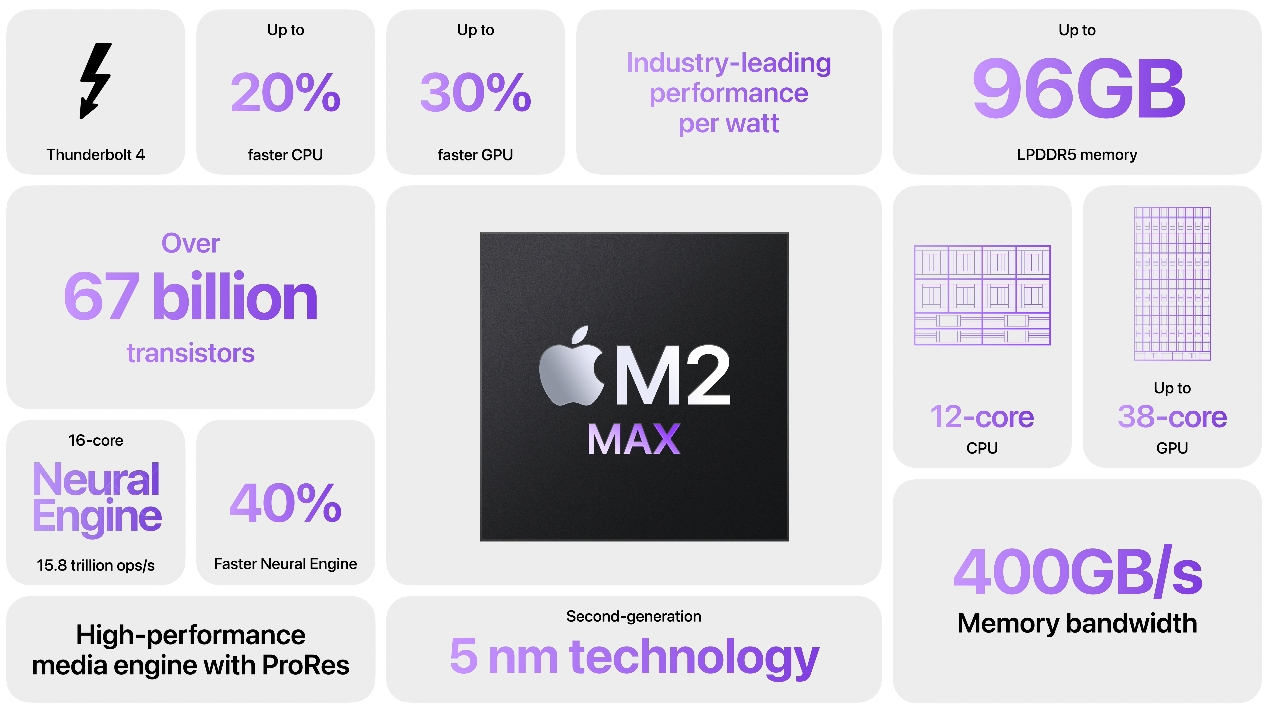Apple Releases M2 Pro and M2 Max: 20 Percent Faster, Up to 19 GPU Cores
Apple's new M2 Pro and M2 Pro max feature up to 12 CPU cores and up to 38 GPU cores.
Despite reports that M2 Pro and M2 Max-based products were delayed yet again, Apple today announced the launch of new MacBook Pros and Mac Minis using the new SoCs. The M2 Pro and M2 Max are more powerful versions of the M2 launched last year in the MacBook Air.
As Apple explains, the M2 Pro “scales up” the M2, giving customers 10 or 12 CPU cores and up to 19 GPU cores. The 12-core configuration has eight high-performance cores and four efficiency cores. For comparison, the M2 in the MacBook Air comes with an 8-core CPU and either an 8- or 10-core GPU. The M2 Pro can also be paired with up to 32GB of unified memory.

Apple claims that the 12-core M2 Pro is up to 20 percent faster than the 10-core version of the M1 Pro in multi-threaded apps. With the new 19-core GPU (three more than the M1 Pro’s GPU), performance is up to 20 percent faster.
For a real-world example, Apple says that the 16-inch MacBook with the M2 Pro is 25 percent faster than its M1 Pro counterpart while compiling in Xcode. It’s also allegedly 2.5x faster than the legacy 16-inch MacBook Pro with an Intel Core i9 processor. In addition, image processing in Photoshop is reportedly 40 percent faster than the M1 Pro and 80 percent faster than the Core i9.
|
M2 Pro |
M2 Pro Max | |
|---|---|---|
|
Process Technology |
5-nanometer |
5-nanometer |
|
Number of Transistors |
40 billion |
69 billion |
|
CPU Cores |
10 or 12 cores |
12 cores |
|
GPU Cores |
16 or 19 cores |
19 or 38 cores |
|
Max LPDDR5 Memory |
32GB |
96GB |
|
Unified Memory Bandwidth |
200GB/s |
400GB/s |
|
Neural Engine |
16-core |
16-core |
The M2 Max is the flagship SoC and has the same 12-core CPU as the M2 Pro but doubles the maximum number of GPU cores to 38. Performance is further enhanced by doubling unified memory bandwidth to 400 GB/s compared to 200 GB/s for the M2 Pro. As a result, graphics performance is up to 30 percent faster than the preceding M1 Max. While the M2 Pro can be paired with a maximum of 32GB of memory, the M2 Max triples that figure to 96GB.

The M2 Pro and M2 Max are built on a 5nm process node, packing 40 billion transistors and 67 billion transistors, respectively. The two chips also share a 16-core Neural Engine capable of executing nearly 16 trillion operations per second (a 40 percent uplift compared to the previous generation). Other features include an enhanced version of the Secure Enclave security platform and a beefed-up media engine.
The M2 Pro is available in refreshed versions of the Mac mini, 14-inch MacBook Pro and 16-inch MacBook Pro. The M2 Max is only available on the new MacBook Pros. All of the M2 Pro- and M2 Max-equipped Macs ship on January 24th.
Get Tom's Hardware's best news and in-depth reviews, straight to your inbox.

Brandon Hill is a senior editor at Tom's Hardware. He has written about PC and Mac tech since the late 1990s with bylines at AnandTech, DailyTech, and Hot Hardware. When he is not consuming copious amounts of tech news, he can be found enjoying the NC mountains or the beach with his wife and two sons.
-
PlaneInTheSky “80 percent faster than MacBook Pro with an Intel Core i9 processor.”Reply
All while maintaining very low power consumption.
ARM is taking the sledgehammer to x86.
Can't wait for next gen's ARM on Windows systems. Hopefully Microsoft gets their act together, because Apple is in a league of its own right now. -
Heat_Fan89 I picked up a base Mac Mini. I had to laugh at their presentation about the new M2 Pro being five times faster than the most powerful Intel desktops. Okay, lets see them run AAA PC games.Reply -
Elusive Ruse Nvidia, AMD and Intel gotta take lessons from Apple on how to blow smoke up their own butts.Reply -
RandomWan ReplyPlaneInTheSky said:“80 percent faster than MacBook Pro with an Intel Core i9 processor.”
All while maintaining very low power consumption.
ARM is taking the sledgehammer to x86.
Can't wait for next gen's ARM on Windows systems. Hopefully Microsoft gets their act together, because Apple is in a league of its own right now.
That's a 9th gen processor and a claim of superiority at one task with no actual benchmark numbers to backup the claim. I'll wait for real world results against the latest in Intel/AMD. -
JamesJones44 ReplyPlaneInTheSky said:“80 percent faster than MacBook Pro with an Intel Core i9 processor.”
All while maintaining very low power consumption.
ARM is taking the sledgehammer to x86.
Can't wait for next gen's ARM on Windows systems. Hopefully Microsoft gets their act together, because Apple is in a league of its own right now.
I'm no Intel fan, but you are comparing Apple's brand new processor to an Intel processor that is 4 generations old. 80% isn't all that exciting when you are talking about 4 generations back. -
ezst036 ReplyHeat_Fan89 said:Okay, lets see them run AAA PC games.
If wanting to play games on a PC but stay away from Windows the best bet is to move to Linux. Apple hasn't seemed to take gaming seriously for many years and the move to ARM introduces a complication. Meanwhile Valve is extremely hungry and doing everything it can to serve gaming customers and has been for well over a decade. -
zecoeco As I expected, minor improvements with the expense of power. This is how it is when you stay on the same node.Reply -
hannibal ReplyPlaneInTheSky said:“80 percent faster than MacBook Pro with an Intel Core i9 processor.”
All while maintaining very low power consumption.
ARM is taking the sledgehammer to x86.
Can't wait for next gen's ARM on Windows systems. Hopefully Microsoft gets their act together, because Apple is in a league of its own right now.
The problem of Windows is that it try to maintain compatibility with older programs... That makes it really hard to make good ARM windows (without losing that compatibility) So I don´t expect big jump of ARM in windows, unless you use Windows S or what ever that strip down Windows is at this moment. -
JamesJones44 Replyhannibal said:The problem of Windows is that it try to maintain compatibility with older programs... That makes it really hard to make good ARM windows (without losing that compatibility) So I don´t expect big jump of ARM in windows, unless you use Windows S or what ever that strip down Windows is at this moment.
I strongly disagree with this. When the first M1 Mac came out there was no ARM based software yet it ran everything the x86 versions did (all be it a slower than their later to come native counter parts). If MS invested the time and money into decent translation like Apple did, they could make it just as compatible as Apple did with their software.